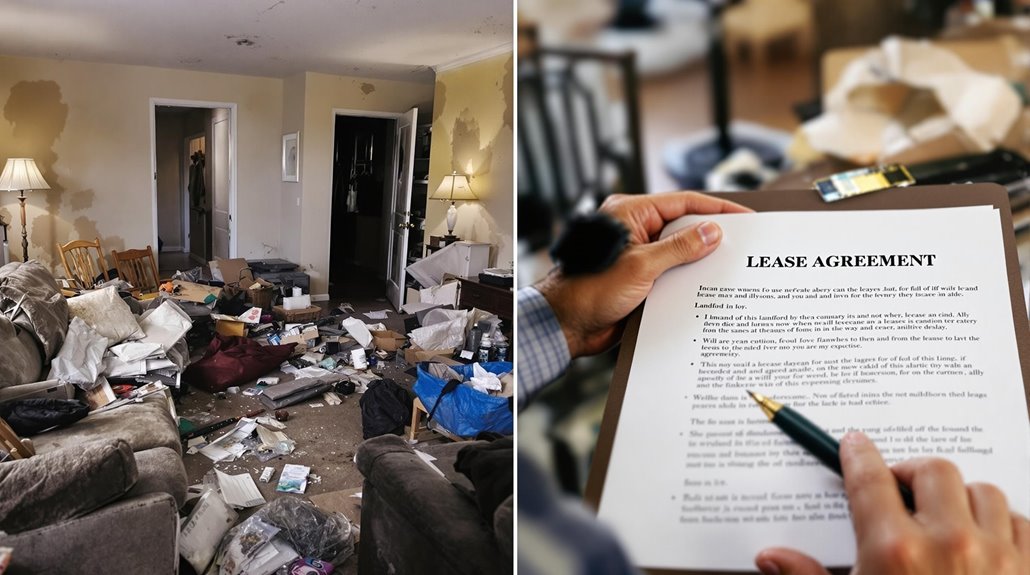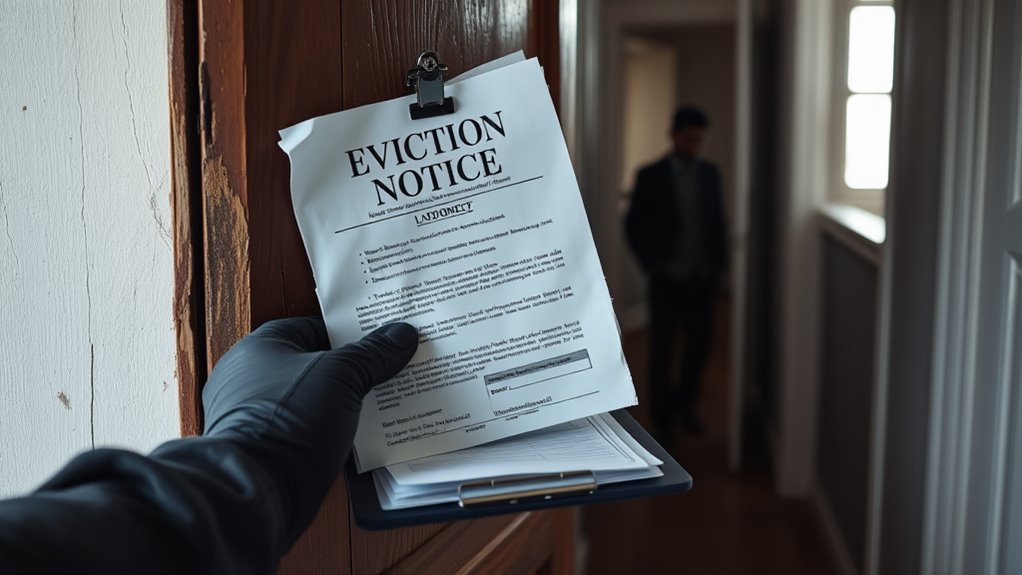Handling problem tenants requires adhering to legal guidelines while maintaining firm yet fair property management. You must guarantee lease terms clearly outline rent payments, maintenance responsibilities, and prohibited activities to prevent disputes. Address late payments promptly with formal notices and consider payment plans to resolve issues amicably. For property damage or unauthorized alterations, document thoroughly and enforce lease provisions. Always follow jurisdictional eviction procedures, providing proper notice and respecting tenant rights. Discover further insights to navigate these challenges effectively.
Key Takeaways
- Issue formal written notices for non-payment or lease violations, following state eviction laws.
- Maintain detailed records of communications, inspections, and property conditions to resolve disputes.
- Include clear late payment penalties and maintenance responsibilities in lease agreements to prevent misunderstandings.
- Conduct thorough tenant screening to identify potential issues before signing leases.
- Seek legal counsel to ensure compliance with local eviction and landlord-tenant laws.
How to Handle Problem Tenants : Understanding Tenant Rights and Landlord Responsibilities
Although tenant-landlord relationships can be complex, understanding the fundamental rights and responsibilities is crucial for maintaining a fair and lawful rental arrangement. Tenant rights guarantee you’re entitled to a habitable living space, meaning landlords must comply with health and safety codes and address repair requests promptly. Landlord responsibilities include providing a written lease agreement that clearly outlines rent terms, maintenance duties, and other legal obligations to prevent disputes. During the screening process, landlords must adhere to fair housing laws, avoiding discrimination based on race, color, religion, sex, national origin, familial status, or disability. You also have the right to privacy, requiring landlords to provide proper notice before entering the property, except in emergencies. If the eviction process becomes necessary, you’re entitled to legal representation and must receive proper notice, guaranteeing an opportunity to respond before any legal action is taken.
Identifying Common Types of Problem Tenants
You may encounter tenants who frequently delay rent payments, creating financial strain for your property management. Others may cause significant property damage through negligence, necessitating stringent documentation of pre-lease conditions. Additionally, unauthorized guests or subletting can pose liability risks, requiring clear lease terms and regular inspections to guarantee compliance.
Late Rent Payments
Late rent payments are one of the most frequent challenges landlords encounter, often stemming from tenants categorized as “Day Late and A Dollar Short.” These individuals consistently struggle to meet payment deadlines, disrupting financial planning and property management. To address this issue, ensure your lease terms explicitly outline penalties for late payments, including applicable late fees, typically ranging from 5% to 10% of the monthly rent. Implement systematic tenant screening to identify those with a history of delayed rent payments. Automate reminders to reduce incidents of late payments and maintain open communication with tenants facing financial hardships to explore amicable solutions, such as payment plans. Consistent enforcement of lease terms is critical to prevent legal issues and claims of unfair treatment. Familiarize yourself with state-specific eviction processes, such as Texas’s 3-day notice, to streamline handling persistent late payers.
- Clearly define late payment consequences in lease terms to avoid ambiguity.
- Automate rent reminders to encourage timely rent payments.
- Stay proactive by screening tenants thoroughly to identify payment risks.
- Use a security deposit as a safeguard against recurring late payments.
- Enforce lease terms uniformly to mitigate potential legal issues.
Property Damage
Property damage caused by problem tenants, such as the “Bull in a China Shop” or “Damaging DIYer,” can result in costly repairs and diminished property value. To address this, you should conduct regular inspections and maintain detailed move-in condition reports. These steps help document the rental property’s status and hold tenants accountable for any property damage. Include clear maintenance expectations and damage liability clauses in your lease agreement to mitigate risks associated with maintenance issues caused by tenants. Unauthorized improvements often lead to legal matters, as tenants may be required to restore the property to its original condition. Additionally, effective tenant screening processes can reduce the likelihood of renting to individuals who are prone to causing damage. Understanding market rent analysis can also help you set optimal rental prices that attract responsible tenants and minimize risks.
| Tenant Types | Common Issues |
|---|---|
| Bull in a China Shop | Negligence leading to major damage |
| Damaging DIYer | Unauthorized alterations |
| Neglectful Occupant | Ignoring minor maintenance issues |
| Careless Resident | Damage from misuse of property |
| Unauthorized Improver | Property altered without consent |
Unauthorized Guests
Unauthorized guests pose significant risks to rental properties, often leading to liability concerns and lease violations. As a landlord, you must address this common problem promptly to protect your property and uphold lease agreements. Including explicit clauses prohibiting unauthorized subletting or extended guest stays without written consent is essential. Conduct periodic inspections to identify unauthorized occupants and guarantee compliance with local laws. Tenants must inform you of any long-term guests to maintain transparency. Clear communication about guest policies in the lease can prevent disputes.
- Prohibit unauthorized subletting in lease agreements to mitigate risks.
- Conduct periodic inspections to detect unauthorized occupants.
- Require tenants to notify you of extended guest stays.
- Guarantee lease terms align with local laws governing tenant rights.
- Address unauthorized guest issues promptly to avoid liability.
Proactive Measures to Prevent Tenant Issues

While tenant issues can disrupt rental operations, taking proactive measures can mitigate potential problems before they arise. Implement a rigorous tenant screening process, including credit and background checks, to minimize the risk of leasing to problematic individuals. Establish clear lease terms that outline late payment policies, maintenance responsibilities, and other
Legal Steps for Addressing Non-Payment of Rent
When non-payment of rent occurs, it is vital to address the matter promptly and in accordance with legal requirements to protect your interests as a landlord. Non-payment of rent is among the most common property management issues, and resolving it requires adherence to state laws to avoid legal complications. As a landlord, you must guarantee that your lease agreement clearly outlines rent payment terms, including due dates and penalties for late payments. Documenting all communication regarding rent issues is essential for maintaining a clear record should the matter escalate. Exploring loan modification options can also provide a viable solution to financial distress that may lead to non-payment.
- Issue a formal written notice, such as a pay or quit notice, as required by your state laws.
- Consider offering tenants a temporary payment plan to resolve the issue amicably.
- Keep meticulous records of all rent-related correspondence and missed payments.
- Consult with a legal professional specializing in landlord-tenant law to guarantee compliance.
- Follow jurisdictional eviction procedures if non-payment persists, avoiding self-help measures.
Handling Property Damage and Lease Violations

Property damage and lease violations can greatly impact your rental property’s condition and value, making it critical to address these issues systematically and in compliance with legal standards. As property managers, you must conduct regular property inspections to identify damages or lease violations early, preventing escalation. Document all findings meticulously, including detailed move-in inspections and before-and-after photos, to establish clear evidence for claims against security deposits. Ascertain lease agreements explicitly outline tenant responsibilities for maintenance and prohibit unauthorized alterations, minimizing disputes. State laws often require proper notice and documentation when charging tenants for repairs, so adhere to these procedures strictly. Maintain transparent communication with tenants about their obligations to foster cooperation and reduce misunderstandings. Utilizing tools like the Long Term Rental Calculator helps assess potential financial impacts of property damage and lease violations on your investment. By addressing property damage and lease violations promptly and legally, you preserve your property’s integrity and uphold a professional landlord-tenant relationship.
Navigating the Eviction Process Legally and Effectively
You must adhere to eviction notice requirements while respecting tenant rights to guarantee a lawful process. Tenants retain the right to contest evictions and request hearings, which you must accommodate within legal frameworks. Familiarity with these obligations protects both your interests and the tenant’s lawful entitlements.
Eviction Notice Requirements
Although eviction laws vary by jurisdiction, landlords must assure eviction notices contain specific, legally mandated details, including the tenant’s name, property address, reason for eviction, and the date by which the tenant must vacate. Compliance with these requirements is critical to avoid legal setbacks, such as case dismissal or delays. Ascertain you use the correct type of notice—pay or quit, cure or quit, or unconditional quit—based on the grounds for eviction. Most jurisdictions mandate written notices, with notice periods ranging from 3 to 30 days. Retain copies of all notices and communications to establish a clear record for potential legal proceedings.
- Include tenant’s full name and property address.
- Specify the reason for eviction clearly and accurately.
- State the vacate deadline in compliance with local laws.
- Use the appropriate notice type for the eviction grounds.
- Document and retain copies of all notices and correspondence.
Tenant Rights Overview
When facing eviction, tenants are entitled to specific legal protections that guarantee the process is conducted fairly and in accordance with the law. Your tenant rights include receiving a proper eviction notice, which must specify the reason and provide a time frame to address the issue, such as unpaid rent or lease violations. You retain the right to respond to an eviction suit by filing an answer in court, where you can challenge the claim on grounds like improper notice, retaliation, or uninhabitable conditions. During the hearing, you may present evidence and arguments before a judge. Additionally, you can negotiate with your landlord to resolve disputes and avoid eviction. If you miss a hearing, you may file a motion to set aside a default judgment, provided you act promptly and establish valid reasons for your absence. For added legal protection, consider consulting trusted legal services like LegalZoom or Rocket Lawyer to ensure compliance and proper documentation.
Conclusion on how to handle problem tenants
Dealing with problem tenants is like steering through a storm; preparation and precision are key. Just as 70% of evictions stem from non-payment, you must document issues meticulously and act within legal bounds. Address violations promptly, using clear communication and written notices. Eviction, your last resort, demands strict adherence to local laws. By staying proactive and informed, you’ll safeguard your property while upholding your rights. Handle each challenge with authority, ensuring fair but firm resolution.




